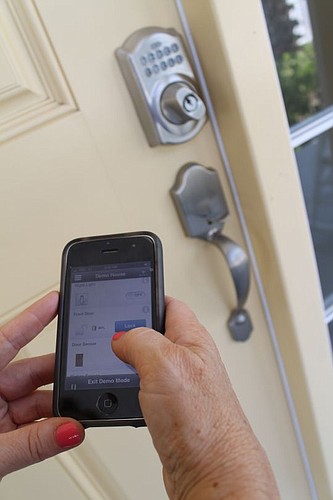
Edmundo Gonzales saw the TV commercial where a man sitting on the front porch of his vacation cabin uses his cell phone to turn off lights, adjust the thermostat and lock the doors at his house.
He wondered if he could do that with Portofino — a 23-unit upscale townhome development planned for Jacksonville’s Intracoastal area — and how expensive it would be.
Gonzales, a managing partner at Urban Partners Construction, would eventually include smartphone-controlled light switches, thermostats, door looks and garage-door openers as standard features in his design. That’s for homes starting in the high $200,000s.
“It’s crazy for me not to use it,” Gonzales said. “We’re in the 21st century. I don’t want to build a 19th or 20th-century home. Why other people aren’t doing this, I have no idea.”
Home automation, for decades the province of wealthy consumers purchasing custom systems for $10,000 to $100,000 and more, is now finding its way into middle America.
Armed with a cellphone and Wi-Fi connection, homeowners can automate air conditioning, lights, locks, cameras, garage doors and electrical outlets by purchasing off-the-shelf products or paying a monthly service contract from a home automation vendor.
“This used to be a very expensive platform,” Gonzales said. “Now because of apps, you can download for free. It’s a very efficient and cost-effective way of getting the same technology.”
In the Jacksonville area, cable and telecom companies Comcast and AT&T offer basic smart home systems. Also, some security companies like ADT offer home automation as an add-on service.
Builders, too, are starting to preinstall home automation.
Lennar Homes began including smart- home devices a year ago as a standard feature in its Jacksonville homes. The company’s package includes a cellphone-controlled thermostat, keyless door lock, security camera and outlet switch, with a $9.99 per month service fee waived for one year.
A customer can use the remote thermostat to help manage energy consumption, the remote door lock to let in cleaning staff and the camera to see inside the home all the way from Europe, said Matthew Figlesthaler, director of sales for Lennar’s Jacksonville division.
“We’re in a technology age and this is just a feature that we feel is important to have, whether you’re paying $150,000 for a home or $1 million,” he said. “It’s something we can give customers that our competitors haven’t offered yet.”
Buyers should manage expectations, though. The entry-level systems don’t replace or closely resemble a custom luxury-home installation.
The inexpensive systems often control just a few functions in a couple of rooms — cameras, a thermostat, a few lights here and there, said Dave Pedigo, senior director of Learning & Emerging Technologies at Cedia, an international association of home automation companies.
Custom systems are designed to automate the entire home, he said. All of the lights are controlled and the surveillance is more sophisticated. An owner has the ability to monitor and control energy use, entertainment systems and automated gates at the front driveway.
“You go from bits and pieces to a total home type of experience,” Pedigo said.
Dan Fulmer, president of Fultech solutions, has for
decades installed custom home automation systems that included garage doors, gates, TVs, audio, pools, spas, water fountains, drapes and shades — even alerts that warn owners when the temperature in the wine cellar is too high or when a septic tank overflows.
Fulmer warns that the low-end products use a variety of technologies that don’t often integrate with each other when expanding a system.
Also, the installation fees may be cheaper, but the recurring monthly charges on many services make for a less attractive
deal.
“The commercials don’t really tell you their service requires a three-year contract,” Fulmer said. “My company can’t compete with a $350 (installation charge), but when you add up the monthly charges, I can compete with $1,200.”
The inexpensive systems for now may have disparate technologies and companies may be searching for the best payment models, but over time the product will evolve, Pedigo said. The manufacturers at the low end will increase their reliability and the products will improve.
“As we get more addicted to our mobile phones and the product prices come down, this will become something that’s available to the masses,” he said. “We’re right on the precipice of what’s being called ‘the Internet of things’ and of everything being connected to the Internet. Widespread home automation is just part of it.”
(904) 356-2466